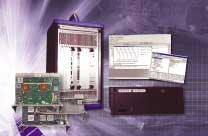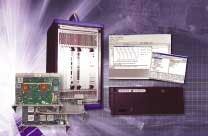By John McHale
BURNABY, British Columbia — Officials at Cubic Defense Applications in San Diego are using flexComm software-defined radio technology from Spectrum Signal Processing in Burnaby, British Columbia, to help develop waveforms in support of the U.S. Department of Defense's Joint Tactical Radio System (JTRS).
The software radio technology is based on Spectrum's SDR-3000 family of software reconfigurable platforms, and is for software-defined radio waveform development.
"Spectrum's COTS (commercial off-the-shelf) SDR-3000 platform, including Version 2.2 of Harris Corp.'s Software Communications Architecture Core Framework (SCA CF), provides for rapid waveform development," says Rick Lober, Senior Vice President and general manager of the Communications and Electronics Business Unit of Cubic Defense Applications.
Under the 18-month contract from the U.S. Army's Communications-Electronics Command (CECOM) at Fort Monmouth, N.J., the Communications Business Unit of Cubic Defense Applications will develop waveform software that will help all branches of the military and several public agencies communicate with one another.
"The military has an interest in communicating with public-safety radios for homeland security and defense reasons," says Gerald Dinkel, president and chief executive officer of Cubic Defense Applications (CDA).
The JTRS is a family of software-definable tactical radios that provide commanders with voice, data, and video capability. The radios are based on a common Software Communication Architecture (SCA) that ensures interoperability or compatibility with current and future systems.
The JTRS goal is to migrate today's relatively old and proprietary radio communications systems to standard open systems. Designers will implement this migration in phases by balancing expenses, user needs, and integration issues.
JTRS had its genesis in lessons learned from interservice communication problems in Grenada and during the Persian Gulf War of 1991, Cubic officials say. Troops were not able to communicate with one another because the various radio equipment used by the different services was not compatible.
Future JTRS-compliant military radios will use SCA-compliant hardware to run a variety of software-based waveforms for the particular communications format a radio is designed to use.
The next generation of software-defined military radios will be able to communicate with new or old radios by downloading the appropriate waveform in software. This interoperability will enable reliable communications between different military forces, Spectrum Signal officials say.
"The software used for these radios can be likened to the software applications that run on a personal computer," Lober says. "It's the change in waveform software that allows these radios to be reconfigurable and interoperable — two key features the joint services consider essential for tactical radio communications, network-centric capabilities, and reduced life-cycle costs."
Spectrum's flexComm technology was the only solution Cubic could find that delivered the signal processing power necessary for their JTRS work, says Manuel Uhm, senior manager of strategic marketing and communications at Spectrum. Extensive signal processing power is necessary in waveform development at this level, he adds.
The flexComm SDR-3000 SDR Development Platform for Cubic is composed of a heterogeneous processing platform incorporating Xilinx field programmable gate arrays (FPGAs), and PowerPC processors from Motorola and IBM, Spectrum Signal officials say. The platform also includes an analog I/O module.
RapidIO provides a fast interconnect fabric between the processors, as well as the I/O to the processors, to ensure efficient use of the processing resources. Software development tools include Spectrum's quicComm Hardware Abstraction Layer to facilitate algorithm partitioning and programming; an SCA CF for the setup and teardown of waveforms as mandated by the JTRS Joint Program Office for all new military communications programs; Spectrum's SCA Board Support Package that enables the SCA CF to identify and manage the platform resources; and a POSIX-compliant real-time operating system, company officials say.
Cubic's software will comply with the Association of Public Safety Communications Officials–25 (APCO-25), established for the use of digital technology in modern-generation two-way radio communications, Cubic officials say.
For information, contact Spectrum Signal at www.spectrumsignal.com.




